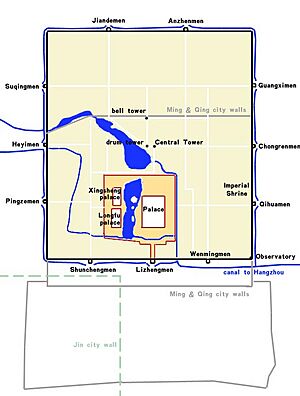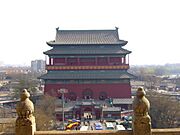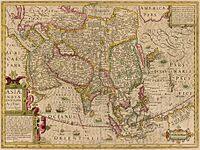Khanbaliq facts for kids
Quick facts for kids Khanbaliq (Dadu of Yuan) |
|
|---|---|
| Native names Chinese: 汗八里 Wade-Giles: Han-pa-li Mongolian: Ханбалиг ᠬᠠᠭᠠᠨ ᠪᠠᠯᠭᠠᠰᠤ Qaɣan balɣasu |
|
| (元)大都 (Yüan) Ta-tu ᠳᠠᠶ᠋ᠢᠳᠤ |
|
 |
|
| Type | Former capital city |
| Location | Beijing, China |
| Founded | 1264 |
| Founder | Kublai Khan |
| Khanbaliq | |||||||||
|---|---|---|---|---|---|---|---|---|---|

Drum Tower and Bell Tower of Beijing
|
|||||||||
| Chinese name | |||||||||
| Chinese | 汗八里 | ||||||||
|
|||||||||
| Mongolian name | |||||||||
| Mongolian Cyrillic | Хаан балгас, Ханбалиг | ||||||||
| Mongolian script | ᠬᠠᠭᠠᠨ ᠪᠠᠯᠭᠠᠰᠤ | ||||||||
|
|||||||||
| Dadu | |||||||||
|---|---|---|---|---|---|---|---|---|---|
| Chinese name | |||||||||
| Chinese | (元)大都 | ||||||||
| Literal meaning | Grand Capital (of Yuan) | ||||||||
|
|||||||||
| Mongolian name | |||||||||
| Mongolian script | ᠳᠠᠶ᠋ᠢᠳᠤ | ||||||||
|
|||||||||
| Beiping | |||||||||
|---|---|---|---|---|---|---|---|---|---|
| Chinese | 北平 | ||||||||
| Literal meaning | [Seat of the] Northern Pacified [Area] | ||||||||
|
|||||||||
Khanbaliq (also called Dadu of Yuan) was an important capital city in China long ago. It was the main winter capital for the Yuan dynasty, a powerful empire ruled by the Mongols. Today, this ancient city is part of Beijing, the capital of China.
Khanbaliq was built right in the middle of what is now modern Beijing. The Yuan dynasty's government, called the Secretariat, managed a large central area from here. This area included places like present-day Beijing, Hebei, and parts of Inner Mongolia. The emperors of the Yuan dynasty, like Kublai Khan, also claimed to rule the entire Mongol Empire. Over time, this huge empire slowly split into smaller parts.
Khanbaliq is the city that Beijing grew out of. You can still find reminders of it today. For example, some subway stations in Beijing are named after the old gates of Dadu.
What's in a Name?
The Meaning of Khanbaliq
The name Khanbaliq comes from the Mongolian and Old Uyghur languages. It means "City of the Khan." A "Khan" was a powerful ruler, like an emperor. This name was used even before the city became a capital.
In English, you might see it spelled Cambaluc. This spelling comes from the famous traveler Marco Polo's stories. He wrote about his travels to China and used this name for the city.
Understanding Dadu
The name Dadu comes from Chinese words. It means "Grand Capital." The Mongols also used a similar name, Daidu, which sounded like the Chinese name.
Today, people often call it Yuan Dadu in Chinese. This helps everyone know it was the capital of the Yuan dynasty, not another city with a similar name.
A Look Back: History of Khanbaliq
From Zhongdu to a New Capital
Before Khanbaliq, there was another capital city nearby called Zhongdu. This was the "Central Capital" of the Jurchen Jin dynasty. In 1215, the famous Mongol leader Genghis Khan destroyed Zhongdu. The Jin rulers then thought about moving their capital south.
Building the Grand Capital
In 1264, Kublai Khan, a grandson of Genghis Khan, visited a beautiful garden. He loved the spot so much that he decided to build his new capital city there. The main architect for this huge project was Liu Bingzhong. Other skilled people, including Guo Shoujing and Yeheidie'erding, also helped.
Construction of the city walls started in 1264. The main imperial palace began to be built in 1274. The city's design followed old Chinese rules. It had a clear layout with "9 vertical and horizontal axes." This meant the city was well-planned and organized.
Dadu Becomes the Yuan Capital
In 1271, Kublai Khan officially started the Yuan dynasty. He declared the new city his capital. He called it Dadu in Chinese and Khanbaliq in Mongolian. The entire city was not finished until 1293. Kublai Khan also had a summer capital called Shangdu, which you might know as Xanadu.
A City of Many Beliefs
The Mongol rulers allowed many different religions in Khanbaliq. This was part of their policy of religious tolerance. You could find followers of Buddhism, Islam, and Christianity living there. There were also Taoist and Confucian groups.
Mongol nobles often respected Taoist and Confucian advisors. Khanbaliq even had a Catholic church for a time.
The End of Yuan Dadu
In 1368, the Ming dynasty army, led by the Hongwu Emperor, attacked Dadu. The last Yuan emperor escaped north to Shangdu. The Ming army then destroyed the palaces in Dadu.
The city was renamed Beiping, which means "Pacified North." A new local government was set up around the city.
Beiping Becomes Beijing
Later, a Ming prince, who became the Yongle Emperor, decided to move the capital back north. His power base was in Beiping. He rebuilt the city, making some parts smaller and adding new areas.
He also created the Forbidden City and Wansui Hill. Once these were finished, he declared the city his northern capital. He renamed it Beijing, which means "Northern Capital." It has been called Beijing ever since.
Khanbaliq's Lasting Impact
The Earth Wall Today
You can still see parts of Khanbaliq's old walls today. They are known as the Tucheng, which means "earth wall." Tucheng Park in Beijing has some of these old northern walls. You can also see modern statues there.
A Name Remembered
Even after the Ming dynasty took over, the Mongols living in Mongolia still called Beijing "Daidu." The last Yuan emperor, Toghon Temür, was sad about losing Khanbaliq and Shangdu. His feelings are written in many Mongolian history books.
For a long time, people in Central Asia and the Middle East still called Beijing "Khanbaliq." This name was used in many travel stories about China.
European Discoveries
When European travelers first reached China by sea in the 1500s, they didn't realize it was the same country Marco Polo had written about. They didn't know his "Cambaluc" was the city the Chinese called Beijing.
It wasn't until 1598 that a Jesuit missionary named Matteo Ricci visited Beijing. He met travelers from Central Asia who confirmed that the city he was in was indeed "Cambaluc." This helped Europeans understand that "Cathay" (Marco Polo's China) was the same as the China they were now exploring.
See also
- History of Beijing
- Names of Beijing
- Shangdu
- Yuan Dadu City Wall Ruins Park




